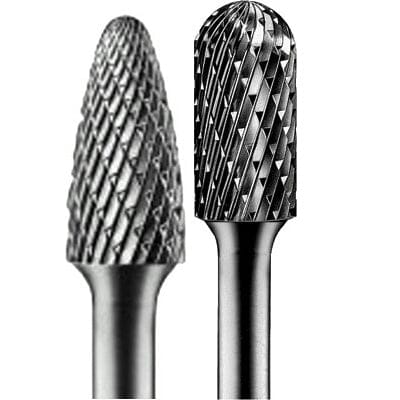Good Design & Manufacture
There are many grades of tungsten carbide, with specialist toolmakers typically offering 10-20 grades although it is thought that there are over 5,000 grades in use. Choosing the right grade for carbide burrs is a balance to obtain the right hardness to cut the metals they are intended for, but avoiding brittleness which could unnecessarily shorten life. In other words, it is not necessarily worth paying higher costs for a harder grade of tungsten carbide, as you could end up with a product that is too brittle for reliability. We therefore choose to use a 'hard metal' grade that is ideal for most ferrous metals, including stainless steel, but may not be suitable for highly specialised metals such as titanium.
Other aspects of a well designed and manufactured carbide burr include a well made and finished joint between the shank and the head to ensure it is suitable for the high rotational speeds of die-grinders.
Shapes
Shapes fall into three main groups, cylinders, cones, rounded edge and one on its own, a potentially very handy inverted cone.
Cylinders: Can have flat end, a cutting flat end or a rounded (domed) end. The flat ends are ideal for small holes, with little benefit in having a working end on a clearance hole or where you don't want to deepen a closed hole further. The dome end is useful in shapes where you don't want to leave a machined scour mark, or on a clearance hole that needs de-burring through to clear properly. 
Conical: Straight sided cones are ideal for reaching into corners. A pointed cone will get right into a corner, but a round (bull nose) cone might be advantageous where you want to smooth off a corner weld, without removing it. There are also 2 cone shaped options for counter sinking, a 60 degree and a 90 degree, to help bed in screws. (These are also handy for woodworking.)

Rounded: The rounded shapes are usually best on curves. The rounded edges range from small radius in ball shapes, increasing through oval, to larger radius in tree and flame shapes. The tree shapes can have either a pointed or a rounded end, making useful contact points on both edge and end.

Inverted Cone: The inverted cone shape enables the backs of rims to be de-burred. As the diameter is usually unimportant for the this, we offer a single diameter on 2 spindle lengths.

Tools:
Most carbide burrs will be used on die-grinders. Most thus have 6mm shanks (spindles) to fit the most popular collets. Power drills with chucks will also work, but obviously, the slower machine speed will result in a slower cut rate. Smaller diameters are often also available with 3mm shanks which will fit craft tools such as Dremmels. The low torques on these machines mean that the diameters of the burrs are necessarily restricted, usually to 3mm, but this often suits the craft work being undertaken with these machines, such as model making or tool making.
Some of the larger burr sizes (approx 16mm dia) have 8mm shanks. This makes them easier to mount in larger machines such as lathes and pillar drills.
Material To Be Worked
Most of the burrs we offer are double fluted, which is preferred for use on ferrous metals, including hard alloys such as stainless steel. The idea of the double fluting is that the cutting action could risk tearing out a swarf strip on some steel grades, if there wasn't a cross-cut to control the chip.
Non-ferrous metals can use a single fluted burr, which has less risk of loading up when used on material such as aluminium.
Both single and double fluted burrs are suitable for wood, but double fluted may result in a neater finish.
Burrs can be used on softer materials such as plastics, but measures should be taken to avoid creating heat, such as minimising the applied pressure and reducing the speed.

